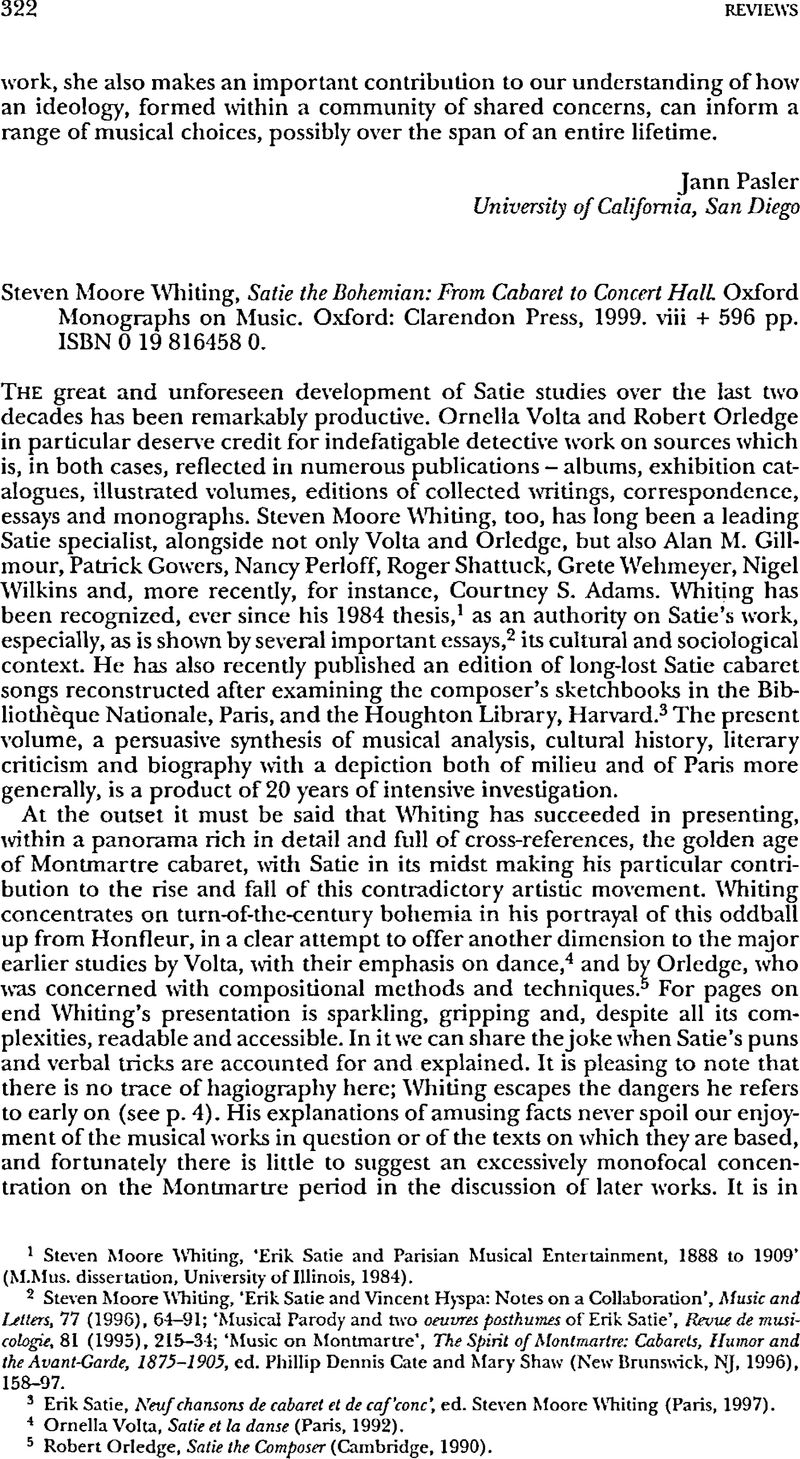No CrossRef data available.
Article contents
Steven Moore Whiting, Satie the Bohemian: From Cabaret to Concert Hall. Oxford Monographs on Music. Oxford: Clarendon Press, 1999. viii + 596 pp. ISBN 0 19 816458 0.
Published online by Cambridge University Press: 01 January 2020
Abstract

- Type
- Reviews
- Information
- Copyright
- Copyright © Royal Musical Association, 2000
References
1 Steven Moore Whiting, ‘Erik Satie and Parisian Musical Entertainment, 1888 to 1909’ (M.Mus. dissertation. University of Illinois, 1984).Google Scholar
2 Steven Moore Whiting, ‘Erik Satie and Vincent Hyspa: Notes on a Collaboration’, Music and Leiters, 77 (1996), 64–91; ‘Musical Parody and two oeuvres posthumes of Erik Satie’, Revue de musicologie, 81 (1995), 215–34; ‘Music on Montmartre’, The Spirit of Montmartre: Cabarets, Humor and the Avant-Garde, 1875–1905, ed. Phillip Dennis Cate and Mary Shaw (New Brunswick, NJ, 1996), 158–97.CrossRefGoogle Scholar
3 Satie, Erik, Neuf chansons de cabaret et de caf'conc’, ed. Steven Moore Whiting (Paris, 1997).Google Scholar
4 Volta, Ornella, Satie et la danse (Paris, 1992).Google Scholar
5 Orledge, Robert, Satie the Composer (Cambridge, 1990).Google Scholar
6 Roy, Jean, ‘La muse et la lyre’, La musique française existe-t-elle? (Le monde de la musique, 229 (February 1999)), 30–1.Google Scholar
7 It should be taken into account that in this provocative collection of aphorisms – an assault on general aesthetic principles by no means exclusively concerned with music – Cocteau expressly gave his views ‘around about music’, not ‘on music'. Whiting employs another happy idea of equal quality in a final homage to Satie's Pièces en forme de poire: he gives the conclusion of his book, his summing up (pp. 557–62), the title ‘En plus’, reflecting the final section of the cycle for four hands.Google Scholar
8 An especially regrettable omission is Eveline Hurard-Viltard's pioneering Le groupe des Six ou le malin d'un jour děte (Paris, 1987); for Satie see esp. pp. 123–30. It is the most thorough general study so far, with the most substantial analysis of musico-aesthetic issues. Also lacking is any use of the well-written, fact-packed reports by contemporaries who witnessed the activities of Satie and Les Six (such as Maurice Sachs, Au temps du Boeuf sur le toit: Journal d'un jeune bourgeois à l'époque de la prospérité, Paris, 1939; Jean Hugo, Avant de l'oublier, Paris, 1976; and idem, Le regard de la mémoire, Paris, 1983). It is not hard to understand why Louis Laloy's retrospect over the period, La musique retrouvée, 1902–1927 (repr. Paris, 1974), does not figure in Whiting's bibliography: Satie never forgave the ‘loathsome’ Laloy his alleged defection to Auric and Francis Poulenc in connection with the quarrels in Monte Carlo in January 1924. To round out the picture attention should also have been drawn, for instance, to Auric's autobiography, Quand j'étais là (Paris, 1979), 21–33. A discussion of passages from Poulenc's correspondence could have shed light on the Mercure quarrel (Poulenc, Correspondance, 1910–1963, ed. Myriam Chimènes, Paris, 1994, 224–5). A kindly backward glance at Satie's achievement as a respected predecessor may be found in Poulenc, Entretiens avec Claude Rostand (Paris, 1954), 46. Milhaud's memoirs, Ma vie heureuse (2nd edn, Paris, 1987), 101–4, should also be consulted in connection with the ‘furniture music’ experiment and Le piège de Méduse. Volta's excellently presented catalogue of the exhibition in March/April 1990 at Neuilly sur Seine, Album des Six: Le groupe des Six et ses amis – 70e anniversaire (Paris, 1990), provides information about parallel activities, the interweaving of aesthetic ideas as well as the outings and occasions shared by Les Six and Satie.Google Scholar
9 Milhaud, Darius, ‘L'évolution du jazz-band et la musique des nègres de l'Amérique du Nord’, Le courrier musical, 35/ix (1 May 1923), 163–4. As early as 1922 Milhaud felt constrained to point out the dangers of spinning legends and creating myths about the origins of Les Six and set the spectacular conditions of their coming together in perspective without disparaging their common goals ('Petit historique nécessaire’, Le courrier musical, 34/ii (15 January 1922), 30).Google Scholar
10 See Rosteck, Jens, ‘Die lapidare Schönheit des Alltags: Darius Milhauds erster Opernversuch, La brebis égarée’, Neue Zeitschrift für Musik, 153 (1992), 220–6.Google Scholar
11 In his excellent analysis of Le piège de Méduse, discussed (pp. 453–60) as pre-Surrealist in the context of Jarry's Ubu Roi and Apollinaire's Les mamelles de Tirésias, Whiting unfortunately fails to mention that Satie's Piège was performed for a second time on 24 May 1921 along with Auric's Les pélicans and Poulenc's Le gendarme incompris. On that evening Pierre Bertin initiated a ‘spectacle de théâtre-bouffe’ and took a major part in it. The omission is understandable. Satie felt mocked and offended by the way Bertin presented his own caricature: juxtaposing Le piège, Les pélicans and, above all, Le gendarme revealed, he thought, both their stylistic and their musical affinities. For details of Bertin's concert, the aesthetics of Poulenc's first operatic work, Cocteau's proverbial interdiction of opera, and the issues raised by a generic-theory definition of the stage works produced by Les Six, see Rosteck, Jens, ‘“Évocation dramatique” oder “Théâtre corrompu”? Das experimentelle Musiktheater der “Groupe des Six” als Versuch einer Orientierung zwischen Nationalismus und Avantgarde’, International Journal of Musicology, 5 (1996), 147–206. The first performance of Le piège took place in private at Roland-Manuel's and, once again, not in a theatre; the activities of Les Six, in this domain too, showed the way.Google Scholar
12 When Whiting notes a similar analogical link between Pièces froides, the title given to a collection of Satie's piano pieces, and the composer's unheated ‘maison du placard’ in Montmartre (p. 181), readers will not be able to suppress a smile at the thought that for once it is not the cabaret poet who is doing the verbal gymnastics.Google Scholar




